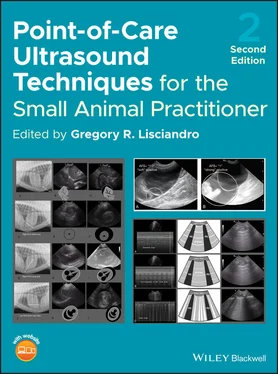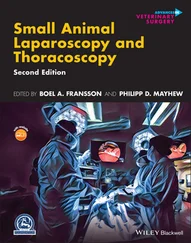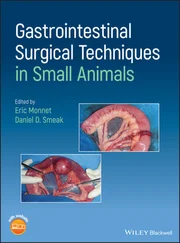Table 7.4. Possible sources of abdominal bleeding on AFAST views.
Source: Reproduced with permission of Dr Gregory Lisciandro, Hill Country Veterinary Specialists and FASTVet.com, Spicewood, TX.
| View |
Possible source |
| DH |
LiverVascularCaudal vena cavaHepatic vesselsPortal vessels |
| SR, HR, SR5th, HR5th |
Spleen (SR, SR5th)Liver (HR, HR5th)AdrenalOvaryVascularCaudal vena cavaAortaRenal vesselsVertebrae |
| CC |
Small intestineLarge intestineReproductive tractUterusProstateVascularCaudal vena cavaAorta |
| HRU, SRU |
LiverSpleenUterusGastrointestinal tract |
In nontrauma, another example would be a postovariohysterectomy bleeding case with an AFS of 1 that is positive at the SR view. Let's say that over time, the patient progresses to an AFS of 3 or 4 that requires surgical exploratory. Logic would dictate the source of bleeding is most likely in the vicinity of the SR view and the left ovarian pedicle would be suspect. This information would again help direct the surgeon to that region as initially AFAST positive for the source of bleeding. In fact, for bleeding postoperative ovariohysterectomy surgeries, the AFAST acoustic windows are in regions of the left ovarian pedicle (SR view), the right ovarian pedicle (HR5th bonus view), and the uterine stump (CC view), which is important to consider in “small‐volume bleeders” that progress to “large‐volume bleeders” requiring surgical intervention. The upshot is that the sonographer should record both the AFS and specifically what AFAST views are positive and negative to maximize patient information as dictated in AFAST goal‐directed templates (see last section of this chapter).
Pearl:Use the AFAST and AFS system as a postinterventional exit exam evaluation, e.g., postoperative and postpercutaneous ultrasound‐guided procedures, before patients are sent home to ensure no occult bleeding is occurring. The use of this strategy is more sensitive than a physical exam, vital signs, and packed cell volume and total solids.
Most Common AFAST‐Positive Sites in Low‐Scoring AFS 1 and 2 Patients
In trauma, the most commonly reported positive sites are the nongravity‐dependent DH and CC views, which is against logic, which would dictate that the most gravity‐dependent HRU view would be more likely to be positive (SRU view in left lateral recumbency) (Lisciandro et al. 2009, 2019; Romero et al. 2015). In nontrauma, the most gravity‐dependent and least gravity‐dependent views were most commonly positive and surprisingly in equal distribution (McMurray et al. 2016), also defying logic. Lastly, in clinically normal puppies and kittens, the DH and CC views were most commonly positive (Lisciandro et al. 2015, 2019; Romero et al. 2015). The upshot is that sonographers should be aware of the pitfalls and artifacts for all AFAST views in order to maximize identifying free fluid over confounders since there is variation in the most commonly detected positive AFAST views between patient subsets and ages. These pitfalls and artifacts are well detailed in Chapter 6.
AFAST Limitations for Intrapelvic Bleeding
People with femoral and pelvic fractures can lose 50–75% of their blood volume at the fracture site, respectively (Coccolini et al. 2017). In dogs and cats, this is uncommon but does occur and should be considered in anemic cases in which the source of the large volume of blood loss is inapparent (Lisciandro 2012). Importantly, FAST has been shown to perform poorly for detecting intrapelvic bleeding and the AFAST sonographer should consider this limitation. Through an understanding of ultrasound and imaging of soft and hard musculoskeletal tissues, however, it seems possible that large blood clots and hemorrhage could potentially be detected at fracture sites through the combined use of B‐mode and color flow Doppler (see Chapters 34and 35).
Use of the AFAST AFS System as an Exit Exam Postintervention
Physical examination, laboratory testing, and radiography are insensitive and unreliable tests for the presence of free fluid in small animals (Rozycki 1998; Rozycki et al. 1998, 2001; Boysen et al. 2004; Lisciandro et al. 2009; Lisciandro 2012; Boysen and Lisciandro 2013; McMurray 2016), and there is no reason to think that this would be different for postinterventional cases. After any invasive procedure that places your patient at risk for bleeding, the AFAST and its applied fluid scoring system should be used as standard of care. By having an AFAST and AFS documented pre‐ and postinterventionally (or, even better, the Global FAST approach – see Chapters 36and 37), during follow‐up examinations the continued use of AFAST and AFS (Global FAST) may help to detect complications earlier in their course.
The value of the FAST approach for postinterventional monitoring has clearly been shown in people (Rozycki 1998; Rozycki et al. 1998, 2001). Initial and serial AFAST with an AFS will help survey for ongoing bleeders. In addition, the technique aids in the detection of “large‐volume bleeders” and may allow the clinician to have a higher index of suspicion for the possibility of overt clinical decompensation than would be possible by waiting on less sensitive traditional indicators such as packed cell volume and vital signs (Rozycki 1998; Bilello et al. 2010). In humans, it is well known that patients can compensate and fool physicians with unremarkable vital signs, mucous membrane color, heart rate, and pulse quality even with an acute loss of 30% of their blood volume (Muir 2006). Dogs are likely more able to compensate due to the blood reservoir provided through splenic contraction. We recommend performing AFAST and assigning an AFS postoperatively and then again as part of daily rounds and/or as part of the patient's exit exam prior to patient discharge. See information on drying the abdomen in a preceding section.
Use of the AFAST AFS System in Nonhemorrhagic Effusions
Patients may become hypovolemic from nonhemorrhagic cavitary effusions and effusions within the retroperitoneal space. Analogous to the hypovolemic bleeding patient, nonhemorrhagic effusions are similarly categorized using the AFS system as “small‐volume effusion” (AFS 1 and 2 or with the modified AFS system <3) versus “large‐volume effusion” (AFS 3 and 4 or with the modified AFS system ≥3). The use of Global FAST helps detect effusions in these three major reservoir cavities and spaces that often are overlooked until effusions are advanced without ultrasound, radiography, and CT. The other two areas surveyed are the smaller reservoirs of the pericardial sac and lung (B‐lines). Smaller in that generally a patient cannot tolerate large volumes of pericardial effusion (heart fails) or many B‐lines representing alveolar‐interstitial edema (lungs fail). Global FAST should be routinely used in all volume‐depleted patients, as is advocated in human medicine (RUSH exam) (Perera et al. 2010), and discussed in more detail in Chapters 36and 37.
An example of the manner in which AFAST with an AFS works in nontrauma monitoring is for the patient with pancreatitis that on day 1 has an AFS of 1 without any AFAST target organ abnormalities. The following day, the Global FAST approach is used, and the AFS has increased to 3. Moreover, Global FAST further evaluates for effusions using TFAST, volume status, and any lung complications using Vet BLUE, and no additional effusions other than the ascites are found. This is significant patient information because likely the disease process is worsening. The finding of an increase from AFS 1 to 3 dictates a more aggressively diagnostic and therapeutic pursuit. Without this approach as an extension of the physical exam, these changes are often missed until the complications advance even more and the patient becomes overtly clinical. In contrast, the following day the AFS has decreased to 0, likely reflecting a positive response to therapy, important information for the clinician as well as the client.
Читать дальше












